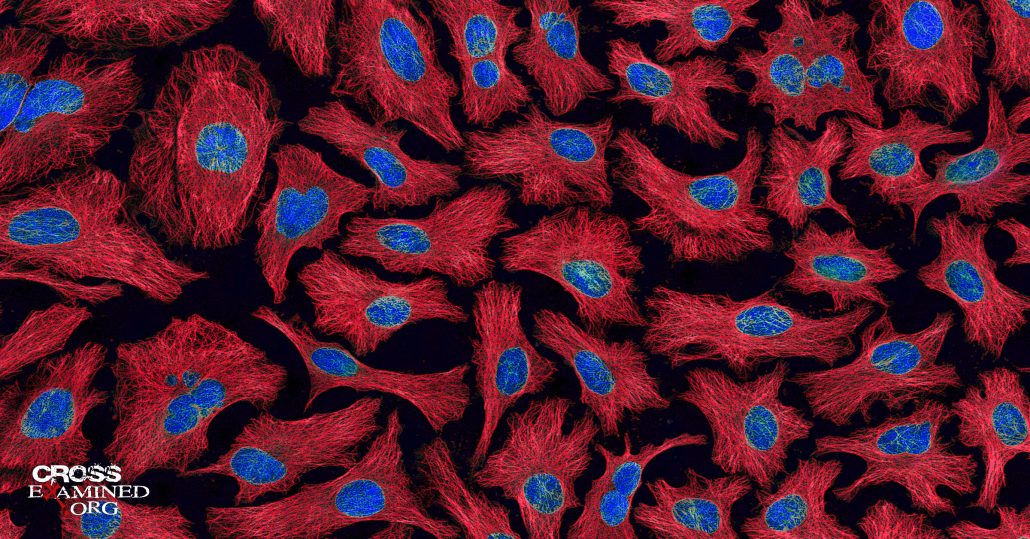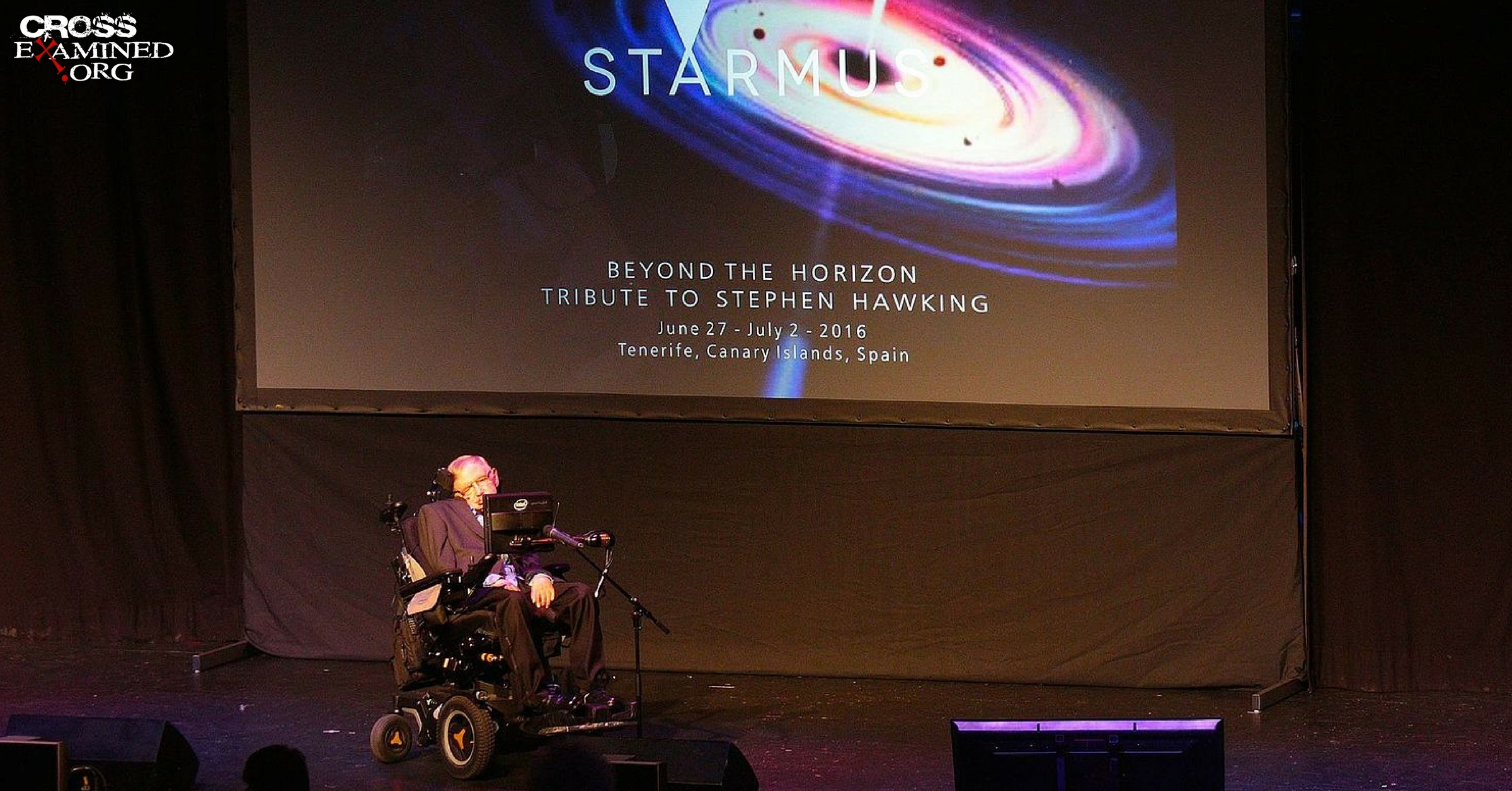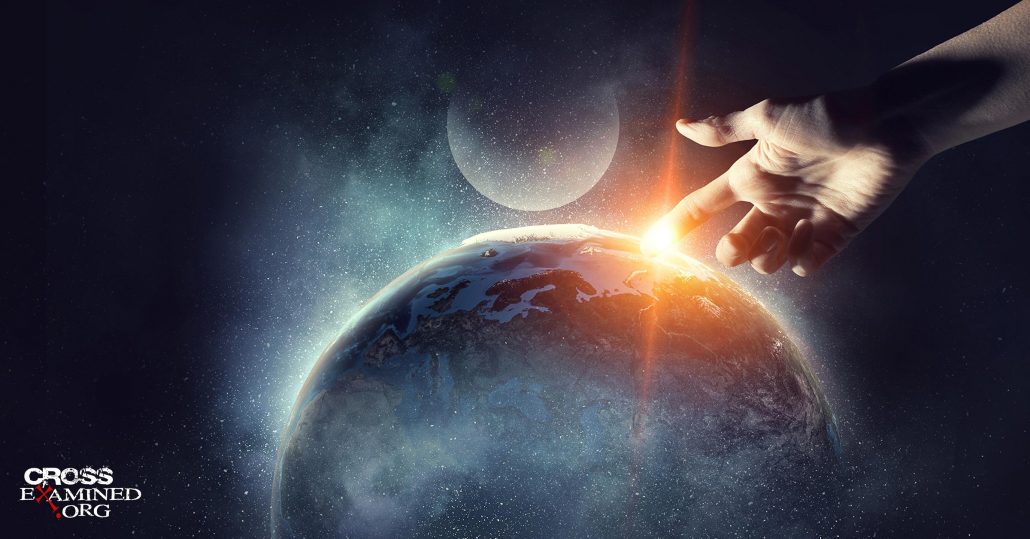Can living cells arise randomly from non-living chemicals?
By Julie Hannah
In Article 1, “The arising of our universe: design or chance?” I discussed evidence for the design behind our finely-tuned universe, which has convinced some mainstream scientists of the existence of a transcendent Creator. In this article, I present recent findings related to the theory that living cells arose through random operations on abiotic (non-living) chemicals.
In 1953, scientists Miller and Urey sent sparks through a mixture of gases to produce amino acids, which are the building blocks of proteins. This seemed to support the theory that life arose on Earth when non-living chemicals randomly combined to form organic compounds, which then spontaneously developed the ability to replicate. However, this process of abiogenesis has been difficult to confirm and model for the following reasons.
Problem 1: Many steps are still not understood
Atheist biologist Richard Dawkins admits that “nobody knows how it happened but, somehow, without violating the laws of physics and chemistry, a molecule arose that just happened to have the property of self-copying” (Climbing Mount Improbable, 259). George Whitesides, who was awarded the Priestley Medal for Chemistry in 2007, also frankly expresses uncertainty: “Most chemists believe, as do I, that life emerged spontaneously from mixtures of molecules in the prebiotic Earth. How? I have no idea” (“Revolutions in Chemistry,” 15). As recently as 2018, geoscientists Kitadai and Maruyama published an extensive review of research results in abiogenesis and were forced to conclude that several steps in the process are still unconfirmed and remain highly hypothetical (“Origins of Building Blocks of Life: A Review,” 1117, 1142).
Problem 2: The first self-replicating molecule has still not been identified
The replication of living cells requires the presence of both protein and DNA (deoxyribonucleic acid). But this poses a chicken-or-egg problem because DNA holds the genetic code for building proteins, but this information can only be accessed if proteins are already present. Philosopher of science Karl Popper explained the problem: “The genetic code is without any biological function unless it is translated; that is unless it leads to the synthesis of the proteins whose structure is laid down by the code. But . . . the code cannot be translated except by using certain products of its translation. This constitutes a really baffling circle” (“Scientific Reduction,” 270). Microbiologist Jack Trevors and cyberneticist David Abel point out that this DNA-protein problem has still not been solved and remains a scientific enigma (“Chance and Necessity,” 734).
To avoid this dilemma, scientists are trying to identify a molecule that arose before DNA, which could have performed both roles: providing genetic information and also promoting self-replication. This might be RNA (ribonucleic acid), but there are some uncertainties: “The most promising candidate is RNA if a mechanism existed on the primitive Earth for the formation of oligoribonucleotides, and if some of these polymers acquired, by chance, the ability to copy their sequences” (Kitadai and Maruyama, “Origins,” 1138, emphasis added). In Whitesides’s opinion, the proposed RNA world “is so far removed in its complexity from dilute solutions of mixtures of simple molecules in a hot, reducing ocean under a high pressure of CO2 that I don’t know how to connect the two” (“Revolutions in Chemistry,” 15). Kitadai and Maruyama explain that many problems remain unresolved regarding the spontaneous arising of RNA (“Origins,” 1141). And molecular scientists Robertson and Joyce express this opinion: “The myth of a small RNA molecule that arises de novo and can replicate efficiently and with high fidelity under plausible prebiotic conditions . . . [is] unrealistic in light of current understanding of prebiotic chemistry” (“Origins of RNA World,” 7). Nobel-winning biochemist Christian de Duve agrees: “Contrary to what is sometimes intimated, the idea of a few RNA molecules coming together by some chance combination of circumstances and henceforth being reproduced and amplified by replication simply is not tenable” (“Beginnings of Life,” 432). Research chemist Leslie Orgel comments: “It is possible that all of these, and many other difficulties, will one day be overcome and that a convincing prebiotic synthesis of RNA will become available. However, many researchers in the field, myself included, think that this is unlikely” (“Prebiotic Chemistry,” 114).
As a result, some scientists are now looking for an even simpler molecule that preceded RNA. However, this precursor has still not been identified. And in any case, as Robertson and Joyce point out, “all of the arguments concerning the relationship between the fidelity of replication and the maximum allowable genome length would still apply to this earlier genetic system” (“Origins of RNA World,” 9).
Professor of chemistry Robert Shapiro also pointed out that there is still no explanation for how the first self-replicating molecule could have been formed (“Small Molecule Interactions,” 106). It cannot have arisen through natural selection because this process can only operate on an existing self-replicating system, which results in another chicken-or-egg problem.
Problem 3: Laboratory experiments might not replicate conditions on early Earth
When scientists synthesize living molecules in the laboratory, they might be using processes that could not have occurred on the primitive Earth. For example, it is not known whether ribozymes (a type of RNA molecule) could have developed from materials that would have been abundant on early Earth (see Robertson and Joyce, “Origins of RNA World,” 12). Kolomiytsev and Poddubnaya reach this conclusion: “No one has found conditions as yet that could result in the formation of ribonucleotides on the primitive Earth. . . Darwin’s ‘warm little pond’ as well as a pond filled with self-copying RNA molecules and concentrated solutions of all the biochemical precursors of RNA could scarcely exist” (“Diffuse Organism,” 69–70).Kitadai and Maruyama write: “Various sites for the origin of life have been proposed, including transient melt zones in a frozen ocean, hydrothermal systems within volcanos, and subterranean lithic zones. Although each setting has advantages in some stages of chemical evolution, unsolved problems also remain” (“Origins,” 1121, emphasis added).
Problem 4: Probabilities are low
The proposed evolution of living molecules from abiotic chemicals is extremely complex and requires at least eight different reaction conditions (see Kitadai and Maruyama “Origins,” 1117). Regarding one hypothetical process for the random arising of adenine (a nucleobase of DNA), Robert Shapiro remarks: “While no single reaction or location in this sequence violates the possibilities of chemistry or geology, the need for them to occur in an exact order creates an implausibility comparable to that involved in generating a particular English sentence by hitting word processor keys at random” (“Small Molecule Interactions,” 110). George Whitesides, therefore, makes this admission about the random arising of living molecules: “Perhaps it was by the spontaneous emergence of ‘simple’ autocatalytic cycles and then by their combination. On the basis of all the chemistry that I know, it seems to me astonishingly improbable” (“Revolutions in Chemistry,” 15).
Nobel Prize-winning chemist Ilya Prigogineexpressed a similar opinion: “The probability that at ordinary temperatures a macroscopic number of molecules is assembled to give rise to the highly ordered structures and to the coordinated functions characterizing living organisms is vanishingly small. The idea of spontaneous genesis of life in its present form is therefore highly improbable, even on the scale of the billions of years during which prebiotic evolution occurred” (“Thermodynamics of Evolution,” 23). In other words, the popular claim that random processes could convert chemicals into living cells over sufficient time is not supported by science.
In short,after more than seventy years of heavily funded international research into abiogenesis, there is still “no plausible scenario that can explain all the stages of the origin of life” (Kitadai and Maruyama, “Origins,” 1121), and there remains an “insuperable gap between pre biological chemistry and the first living systems” (Kolomiytsev and Poddubnaya, “Diffuse Organism,” 76). A clear route from prebiotic chemicals to nucleotides and living cells remains, in Orgel’s terms, “the Molecular Biologist’s Dream” (“Prebiotic Chemistry,” 119). As a result, some scientists now suggest that organic molecules must have been formed somewhere else in the universe and been carried to Earth on meteors to provide the biological basis for life. However, this merely transfers the problem of life’s origins to a different location.
Notes
Adapted from A Skeptic’s Investigation into Jesus, J P Hannah.
https://www.amazon.com/Skeptics-Investigation-into-Jesus/dp/1532674619
Used with kind permission from Wipf and Stock Publishers: www.wipfandstock.com.
References
Dawkins, Richard. Climbing Mount Improbable. Penguin: London, 1996.
———. The God Delusion. New York: Mariner, 2008.
de Duve, Christian. “The Beginnings of Life on Earth.” American Scientist 83 (1995) 428–37.
http://www2.nau.edu/~gaud/bio372/class/readings/beglifeerth.htm
Kitadai, Norio, and Shigenori Maruyama. “Origins of building blocks of life: A review.” Geoscience Frontiers 9 (2018) 1117–153.
https://www.sciencedirect.com/sdfe/reader/pii/S1674987117301305/pdf
Kittel, Charles, and Herbert Kroemer. Thermal Physics. 2nd ed. San Francisco: Freeman, 1980.
Kolomiytsev, Nikolay P., and Nadezhda Ya Poddubnaya. “The Diffuse Organism as the First Biological System.” Biological Theory 5 (2010) 67–78.
Orgel, Leslie E. “The Implausibility of Metabolic Cycles on the Prebiotic Earth.” PLOS Biology 6 (2008) 5–13.
———. “Prebiotic Chemistry and the Origin of the RNA World. Critical Reviews in Biochemistry and Molecular Biology 39 (2004) 99–123.
Popper, Karl R. “Scientific Reduction and the Essential Incompleteness of All Science.” In Studies in the Philosophy of Biology: Reduction and Related Problems, edited by F. J. Ayala, and T. Dobzhansky, 259–84. Berkeley: University of California Press, 1974.
Prigogine, Ilya, et al. “Thermodynamics of Evolution.” Physics Today 25 (1972) 23–28.
Robertson, Michael P., and Gerald F. Joyce. “The Origins of the RNA World.” Cold Spring Harbor Perspectives in Biology 4.5 (2012) a003608.
https://cshperspectives.cshlp.org/content/4/5/a003608.full.pdf+html
Shapiro, Robert. “Small molecule interactions were central to the origin of life.” The Quarterly Review of Biology 81 (2006) 105–26.
Trevors, Jack T., and David L. Abel. “Chance and necessity do not explain the origin of life.” Cell Biology International 28 (2004) 729–39.
Whitesides, George M. “Revolutions In Chemistry: Priestley Medalist George M. Whitesides’ Address.” Chemical and Engineering News 85 (2007) 12–17.
https://cen.acs.org/articles/85/i13/Revolutions-Chemistry.html
Recommended resources related to the topic:
Science Doesn’t Say Anything, Scientists Do by Dr. Frank Turek (DVD, Mp3, and Mp4)
Oh, Why Didn’t I Say That? Does Science Disprove God? by Dr. Frank Turek (DVD and Mp4)
Stealing From God by Dr. Frank Turek (Book)
Macro Evolution? I Don’t Have Enough Faith to be a Darwinist (DVD Set), (MP3 Set) and (mp4 Download Set) by Dr. Frank Turek
Answering Stephen Hawking & Other Atheists MP3 and DVD by Dr. Frank Turek
God’s Crime Scene: Cold-Case…Evidence for a Divinely Created Universe (Paperback), (Mp4 Download), and (DVD Set) by J. Warner Wallace
God’s Crime Scene: The Case for God’s Existence from the Appearance of Design (mp4 Download Set) by J. Warner Wallace
God’s Crime Scene: The Case for God’s Existence from the Appearance of Design in Biology DVD Set by J. Warner Wallace
Julie Hannah is a Mathematics lecturer (recently retired) with a passionate interest in the human condition. As an agnostic, she spent over a decade researching science and the scriptures of various faiths, and the cumulative evidence finally brought her to Christ. She has published her findings in “A Skeptic’s Investigation into Jesus” (Wipf and Stock).












Leave a Reply
Want to join the discussion?Feel free to contribute!